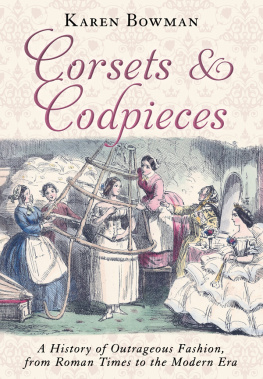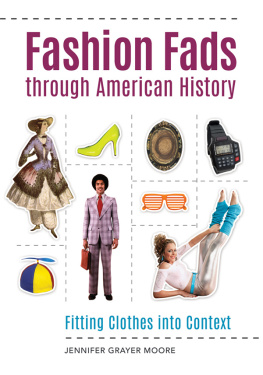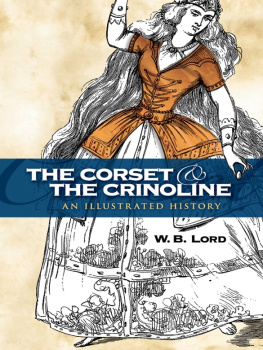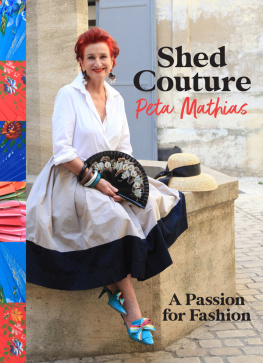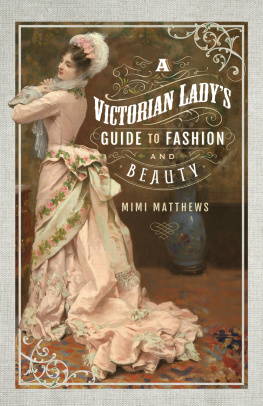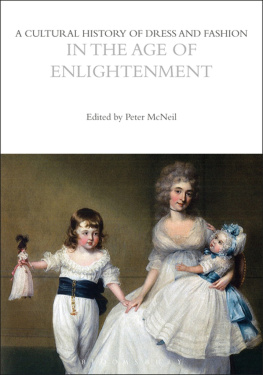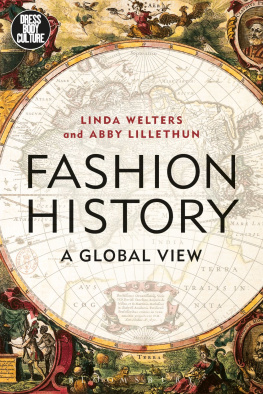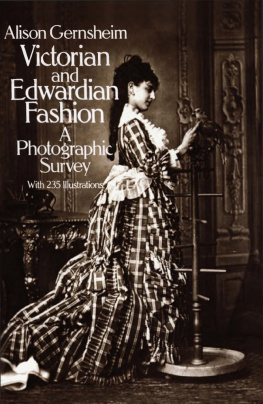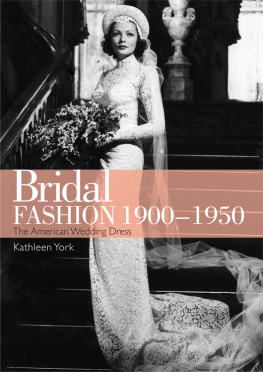This book is dedicated to my fashion-loving granddaughter, Emma Elizabeth
Copyright 2015 by Karen Bowman
First Skyhorse Publishing edition 2016
First published in Great Britain in 2015 by Pen & Sword History, an imprint of Pen & Sword Books Ltd
All rights to any and all materials in copyright owned by the publisher are strictly reserved by the publisher.
All rights reserved. No part of this book may be reproduced in any manner without the express written consent of the publisher, except in the case of brief excerpts in critical reviews or articles. All inquiries should be addressed to Skyhorse Publishing, 307 West 36th Street, 11th Floor, New York, NY 10018.
Skyhorse Publishing books may be purchased in bulk at special discounts for sales promotion, corporate gifts, fund-raising, or educational purposes. Special editions can also be created to specifications. For details, contact the Special Sales Department, Skyhorse Publishing, 307 West 36th Street, 11th Floor, New York, NY 10018 or .
Skyhorse and Skyhorse Publishing are registered trademarks of Skyhorse Publishing, Inc., a Delaware corporation.
Visit our website at www.skyhorsepublishing.com.
10 9 8 7 6 5 4 3 2 1
Library of Congress Cataloging-in-Publication Data is available on file.
Cover design: Domenic Allen
Cover illustration credit: Karen Bowman
Print ISBN: 978-1-5107-0857-0
Ebook ISBN: 978-1-5107-0869-3
Printed in China
Contents
Authors Note
I t is not possible in a book of this size to catalogue every twist and turn of fashion over 2 millennia, and so Corsets and Codpieces encapsulates those trends that era by era both elegantly and outrageously put their stamp upon the past. A social history of costume, it hopes to convey both the pride and the prejudices towards some of the more memorable aspects of clothing, giving you, the reader, a glimpse into what it was like to both wear the clothes as well as witness the attitudes and opinions of the times. Based on both primary sources and contemporary accounts, it promises to make entertaining and at times outrageous reading.
Karen Bowman
Introduction
S hould we ladies or gents ever be transported back in time how thrilling it would be to wear the clothes of the time, except it would take an age just learning how to wear them. Until the early twentieth century a mans shirt was no more than an undergarment and so no self-respecting fellow would ever have appeared in his shirtsleeves, particularly in front of a lady. So used to freedom of movement, we would undoubtedly stumble over the hems of our skirts, struggle to breathe in a corset and fail to master all the languages of the fan. Being a woman in the past was a full-time occupation. We had to learn from childhood how to move in a long skirt: get used to taking little steps and only stride out perhaps when privately taking the air. We had to remember to slew ourselves sideways through a door in our crinolines and walk slightly in front of or behind a companion as it was impossible in such a monstrosity to get too close to anyone. Plus we had to remember to manoeuvre our bustles in such a way as to enable us to be able to sit down without there being a catastrophe.
To lift a skirt was an art, only really needing to be practised when mounting stairs if a girl had correctly learned the art at her mothers knee. She also learned how to gently let her foot push her skirt forward in front of her at the end of every step, thus never becoming entangled in fabric, but also remembering never to let her whole foot show. Turning was done with a single clean movement. In the case of farthingales, eighteenth-century hoops and later crinolines a ladys hands were always clasped in front of her or allowed to rest on the swell of the skirt, enabling her to control it. A womans movement in such garments was always smooth as the slightest unguarded hip movement could set the whole inflated ensemble swinging in all directions!
The woman of yesterday was, just as today, a product of her clothes. During many periods, women had to appear carefree while in the vice-like grip of a corset plus walk smoothly from the knee, as the swaying of hips was considered indecent. In short, a girl had to glide with the effortless grace of a ghost
With modern day knee-length skirts we have become accustomed to crossing our legs. This along with other modern habits are a world away from women sitting with their knees apart in order to create a broad lap, which when sitting would have given our clothes the recommended drape and the sitter poise. Crossing our arms correctly had to be learned. Rarely done when wearing a corset or hooped skirt, it was instead recommended to hold your arms out from your body, elbows bent helping to create an open space on either side of your torso thus drawing attention to your fashionably tiny waist. Arms were allowed to be crossed in the Regency era but only beneath the level of our short stays so as not to spoil the line of our classically inspired gowns and long, willowy figures. This was to be the first time we women were not considered indecent in displaying our bare arms in public, even if it was usually only in the evenings.
What has remained unchanged is the fact that men and women whoever they were and whenever they lived have always communicated by the clothes they wear.
C HAPTER 1
Short Skirts, Long Beards
We live not according to reason, but according to fashion
Seneca, Roman philosopher, mid-first century AD
I n matters of supremacy and conflict it is, as the saying goes, the one who wears the trousers who usually has the upper hand. For centuries wearing braise or britches has been a masculine prerogative affording the wearer vital ease of movement both in battle and physical work, something denied to women until emancipation in the early twentieth century. However, once in our history the opposite was true. When the Romans invaded our shores in the first century AD it was not only their weapons that won them this island. As every victory in history has relied as much on psychology as strategy there is no better illustration of mind over matter than the Roman belief in himself. Thus, his armour atop his customary short tunic gave him, in his mind, that vital edge.

Relief panel of the Great Ludovisi sarcophagus showing the battle scene between skirted Roman soldiers and a heathen enemy in trousers. From a tomb near the Porta Tiburtina, it dates from AD 25060. (Authors collection)
The Roman way of life was totally alien to those living in the far-flung outposts of the Empire and the culture of the trouser-wearing Britains spoke to the invader in volumes. Trousers were the dress of heathens. As skirted and clean cut, the Roman thought himself superior, a natural overlord whose rightful duty was to take our island from those they saw as subordinate. In reality, that idea that men in skirts could actually have the decisive advantage is as unlikely today as it was then, but the Roman ethos of cleanliness in both body and dress elevated them in their own minds above the unclean, long-haired, bearded and trouser-wearing islanders. Once convinced, the Romans were nothing if not confident and as such pulled off one of the only two invasions of Britain.
This scenario is a perfect example of how clothes maketh man; how they define him and how what you wear is as important as what you wield. Self- belief certainly elevated the Roman soldier, in his own mind at least, above his equally formidable foe. Diodorus Siculus, a Greek historian writing about the Celts of Gaul and Britain in the first century, described the Roman opponent as tall and terrifying with rippling muscles under clear white skin. Their hair is blond, but not naturally so: they bleach it, to this day, artificially, washing it in lime and combing it back from their foreheads. They look like wood-demons, their hair thick and shaggy like a horses mane. Their costume he described as astonishing, adding that they wore brightly coloured and embroidered shirts, with trousers called braccae and cloaks fastened at the shoulder with a brooch, this latter garment heavy in winter, but light in summer. Striped or chequered in design, such cloaks had separate checks close together and in various colours, proving perhaps the Dark Ages were perhaps not so dark after all. Such were the British enemies of Rome dressed, with trousers available even to women. This was another reason the Romans shunned what they saw as female garb. In doing so it prevented them from wearing what they considered made them look more the heathen, than the elect. Not about to surrender his native Mediterranean clothing even in the face of the freezing mists of Albion or snows of a Hibernian winter, the common soldier did have tried and trusted cold-weather clothing in the form of cloaks, socks, leg wrappings or bindings called puttees which wrapped from the ankle up to the calf, extra tunics and scarves which went some way to making life in this furthest outpost of the Roman Empire at least bearable. If not, supplies could be requested from Rome, as details from Tablet 255 of the Vindolanda Tablets, discovered in the 1970s and 1980s, disclose:

